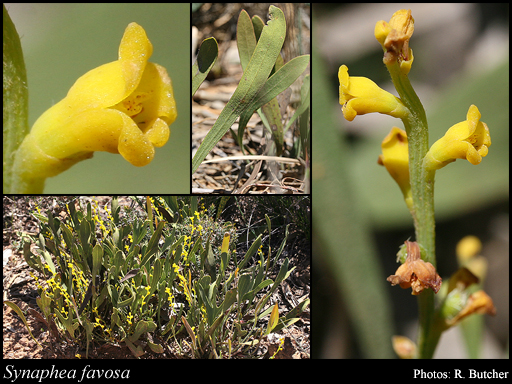- Reference
- Trans.Linn.Soc.London 10:156 (1810)
- Conservation Code
- Not threatened
- Naturalised Status
- Native to Western Australia
- Name Status
- Current
Low spreading, decumbent shrub, 0.05-0.4 m high, to 0.4 m wide. Fl. yellow, Sep to Nov. Sandy soils, sometimes over granite or sandstone.

Scientific Description
Shrubs; branchlets hairy. Leaves alternate, 75-125 mm long, 15-40 mm wide, hairy; petiole hairy; lamina flat, clearly widest above the middle, once divided, tripartitely divided, entire, shallowly divided or deeply divided, indumentum appressed; distance from base of leaf to lowest lobe 45-75 mm; terminal leaf lobe 0 mm long, 0 mm wide; lowest lobes 8-25 mm long. Inflorescences yellow; scape 50-190 mm long; floral bracts 1.5-2 mm long. Perianth 5-6.5 mm long, hairy; adaxial tepal 5-6.5 mm long; abaxial tepal 4-5.5 mm long; ovary hairy, style glabrous; style including stigmatic disc 3.5-4 mm long, horned; stigma 1-1.2 mm long, 0.8 mm wide. Follicles 3-3.5 mm long. Flowers in September, October or November. Occurs in the South-west (SW) Botanical Province(s), in the Avon Wheatbelt (AW), Jarrah Forest (JF), Mallee (MAL), Warren (WAR) or Esperance Plains (ESP) IBRA subregion(s).
Distribution
- IBRA Regions
- Avon Wheatbelt, Esperance Plains, Jarrah Forest, Mallee, Warren.
- IBRA Subregions
- Fitzgerald, Katanning, Recherche, Southern Jarrah Forest, Warren, Western Mallee.
- IMCRA Regions
- WA South Coast.
- Local Government Areas (LGAs)
- Albany, Broomehill-Tambellup, Cranbrook, Denmark, Esperance, Gnowangerup, Jerramungup, Kent, Manjimup, Nannup, Plantagenet, Ravensthorpe.